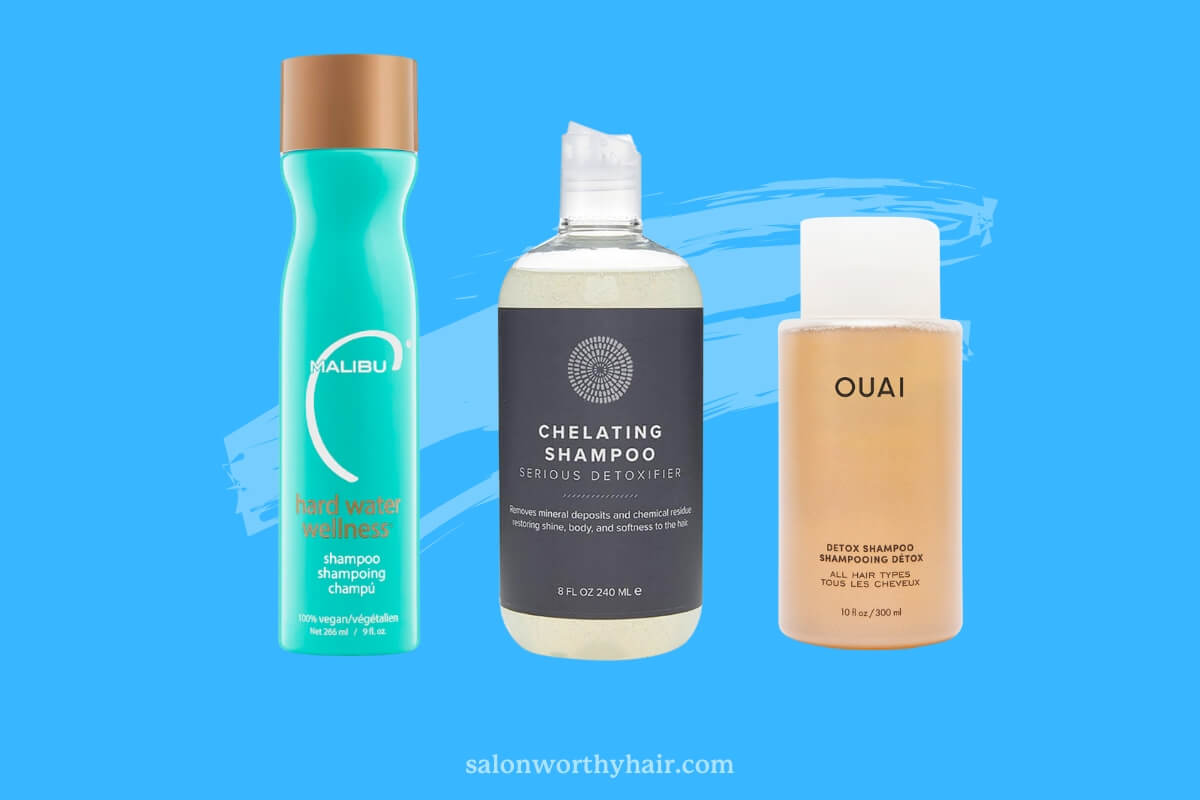7 Best Chelating Shampoos With EDTA to Chelate Your Hair and Scalp
Updated on
This post may contain affiliate links. As an Amazon Associate, we may earn from qualifying purchases.

A chelating shampoo is a specialized hair and scalp cleansing product that removes mineral buildup.
This type of shampoo contains ingredients like EDTA (edetic acid) or citric acid that bind to mineral ions (calcium, magnesium, iron) and traces of metals (manganese, copper, lead) in hard water, preventing them from attaching to the hair.
Unlike regular shampoos, a chelating shampoo is stronger. It deeply cleanses hair of hard water minerals, product buildup, pollutants, and excess oil. It also restores the hair’s natural shine, softness, and manageability, which can be lost due to mineral buildup and environmental factors.
Often formulated to be pH-balanced to maintain the natural acidity of the scalp and hair, a chelating shampoo protects against cuticle damage and hair breakage.
However, due to its potency, a chelating shampoo must be used less frequently than a regular shampoo. It is recommended for use once a week or after exposure to hard water or swimming pools.
We’ve selected a few of the best chelating shampoos that are guaranteed to leave your hair and scalp squeaky clean and demineralized.
1. Malibu C Hard Water Wellness Shampoo
Malibu C Hard Water Wellness Shampoo is an excellent chelating shampoo thanks to its effective blend of L-ascorbic acid and disodium EDTA. These ingredients work together to neutralize the adverse effects of hard water on the hair and scalp.
L-ascorbic acid, a mild chelating agent, is key to the shampoo’s effectiveness in reducing the oxidizing effects of hard water on the hair and scalp. It counteracts free radicals that cause oxidative stress and damage to hair follicles and the scalp.
Disodium EDTA complements L-ascorbic acid by removing mineral and metal ions, ensuring thorough chelation.
Pros
- Detoxifies your locks
- Makes hair soft and manageable
- Sulfate-free and paraben-free
- Removes mineral deposits
- Vegan
- Cruelty-free
Cons
- Not for color-treated hair
2. Hairprint Chelating Shampoo
The Hairprint Chelating Shampoo removes calcium, magnesium, and other mineral deposits left behind by hard water.
This shampoo uses plant-based chelating agents: Tetrasodium glutamate diacetate, citric acid, and pomegranate ferment instead of synthetic chelators. It also includes glucose cleanser, radish root, elderberry extract, and evening primrose oil for cleansing and conditioning.
The Hairprint shampoo is gentle on the hair and scalp. It ensures that it strips away unwanted minerals and does not strip the hair of its natural oils.
Formulated for all hair types, including color-treated hair, the Hairprint shampoo delivers a triple-effective hair wash: it detoxifies the hair from the buildup of styling products, environmental pollutants, and hard water minerals and metals.
Pros
- Plant-based and vegan
- Paraben-free and sulfate-free
- Bioavailable
- Gentle enough for dry hair and sensitive scalps
- Exfoliates and stimulates the scalp
Cons
- Low suds
3. Bumble and Bumble Sunday Shampoo
The Bumble and Bumble Sunday shampoo is a weekly hair and scalp detoxifying shampoo.
The shampoo contains tetrasodium EDTA, a chelating agent that inhibits the effects of minerals found in hard water. These minerals can interfere with the effectiveness of soaps, detergents, and regular shampoos.
Tetrasodium EDTA binds to these minerals, effectively “softening” the water and allowing the soap or detergent to lather more easily and clean more effectively. This chelation process prevents the minerals in hard water from depositing on the skin or hair, which can lead to dryness or a dull appearance.
The Bumble and Bumble Sunday shampoo also removes product residue, excess oil, and pollutants, providing your hair with a fresh and clean start.
Other ingredients include panax ginseng root extract, rosemary leaf extract, and sage leaf extract. These natural extracts nourish the scalp and hair, enhancing overall hair health. The pleasant herbal scent adds to the refreshing experience, making your hair-washing routine more enjoyable.
Pros
- Removes product residue, oils, and pollutants
- Contains anti-inflammatory and antiseptic properties
- Soothes dry and itchy scalps
- It can be used to prime your hair before coloring
Cons
- Contains sodium laureth sulfate
- May strip hair dye
4. Ouai Detox Shampoo
The OUAI Detox Shampoo is crafted with apple cider vinegar to dissolve and purge impurities and mineral deposits from the hair and scalp.
Acetic acid, the main active component in apple cider vinegar, is known for its ability to break down various substances. It can help dissolve hard water minerals, rust, and other deposits that might cling to the hair or stick to the scalp.
This is why apple cider vinegar is often touted as a natural hair rinse to combat the effects of hard water.
ACV is also beneficial for restoring the hair’s natural pH balance, which can be disrupted by alkaline hair products or hard water. By removing build-up and residue, ACV leaves hair smoother, shinier, and more manageable.
Pros
- No parabens
- Contains hydrolyzed keratin
- Cleanses without stripping the hair
- Hair nourishing and softening
- Smells amazing
Cons
- Contains mild sulfates
5. L’oreal Professionnel Metal Detox Shampoo
The L’Oréal Professionnel Metal Detox Shampoo is specifically formulated to combat the detrimental effects of copper and other metal ions commonly found in hard water that lead to hair discoloration, brittleness, and color fading.
The shampoo’s effectiveness hinges on its patented ingredient, Glicoamine.
As described by L’Oréal’s color specialist, Roz Orr, Glicoamine is a molecule small enough to penetrate hair fibers and chelate metal particles. Charlotte Feltin, head of L’Oréal Haircare Laboratories, underscores that Glicoamine is unique in its ability to bind and neutralize metal particles in the hair without damaging its integrity.
This shampoo is particularly beneficial for individuals residing in areas with hard water, especially where residential water pipes are older and more prone to metal erosion. It’s a perfect solution for those experiencing a shift in hair color to an unwanted coppery hue due to metal deposits.
Pros
- Prolongs hair color
- Prevents metal ion absorption in hair
- Removes brassiness
- 97% less breakage
- 2X color vibrancy and shine
- Perfect for after lightening, balayage, and bleaching
Cons
- Pricey
- Small bottle
6. Pattern Beauty Cleansing Shampoo
The Pattern Cleansing Shampoo, tailored for the unique needs of type 3 and type 4 curly hair, incorporates disodium EDTA in its formulation to guard against metal-catalyzed oxidation.
Metal-catalyzed oxidation is a chemical process where metal ions in hard water act as catalysts to accelerate the oxidation of various substances.
Oxidation occurs when hard water metals like iron, copper, and magnesium facilitate electron transfer, leading to organic compound degradation. This process can have several detrimental effects on the hair. For example, metal-catalyzed oxidation can cause protein degradation, rapid fading and changes in hair color, altered hair texture, and loss of shine.
The Pattern Cleansing Shampoo prevents this type of hair degradation. Its careful formulation not only inhibits oxidative effects of hard water but also safeguards the natural oils and moisture of the hair, making it an ideal product for maintaining healthy, vibrant curls.
Pros:
- Contains green tea, aloe vera, and panthenol
- Does not strip hair
- Excellent for low porosity hair
- Very gentle
- Pleasant fragrance
Cons:
- Small bottle
7. Maple Holistics Sulfate-Free Hard Water Shampoo
Maple Holistics sulfate-free hard water shampoo is a mild chelating shampoo with sodium citrate as its key ingredient.
Sodium citrate is not as potent as traditional chelating agents like EDTA. It offers a gentler alternative, helping to reduce the impact of hard water on hair and maintaining the integrity of the product. While primarily a pH adjuster, sodium citrate can mildly chelate metal ions, mitigating hard water’s impact on hair and skin.
This formula is enriched with peppermint, bergamot, and eucalyptus mint essential oils, providing a refreshing and invigorating experience. It’s an ideal choice for those looking to avoid harsh chemicals, as it’s free from sulfates and parabens.
This shampoo is an excellent choice for everyday use, particularly for those preferring natural ingredients and a sulfate-free clarifying treatment while still addressing the challenges posed by hard water.
Pros:
- Everyday use
- Nourishing and hydrating
- Refreshes the scalp
- Fights dandruff
Chelating Shampoo Buying Guide
When buying a chelating shampoo, it’s important to consider several factors to ensure you select a product that effectively meets your hair care needs.
Below is a list of essential factors to consider:
- Chelating Ingredients: Look for shampoos that contain known chelating agents like disodium EDTA, tetrasodium EDTA, or sodium gluconate.
- Hair Type Compatibility: Ensure the shampoo is suitable for your hair type. If you have curly, dry, or color-treated hair, you might need a chelating shampoo with moisturizing or color-protecting properties.
- Mildness of the Formula: Chelating shampoos can be more stripping than regular shampoos. If you have dry or sensitive scalp, look for products that balance chelating agents with hydrating ingredients like glycerin, natural oils, or aloe vera.
- Frequency of Use: Chelating shampoos are typically not meant for daily use due to their deep cleansing properties. Check the recommended usage frequency to align with your hair care routine, especially if you have dyed or chemically treated hair.
- PH-Balanced Formulas: A pH-balanced shampoo helps maintain the natural acidity of the scalp and hair, which is important for overall hair health and can enhance the benefits of chelating agents.
- Additional Benefits: Some chelating shampoos offer additional benefits like UV protection, anti-frizz, or volumizing properties. Consider other hair care needs.
- Sulfate-Free Options: For gentler cleansers, look for sulfate-free chelating shampoos. While sulfates are effective cleansers, they can be harsh on certain hair types.
How to Use a Chelating Shampoo
Here are the step-by-step instructions on how to use a chelating shampoo safely:
- Wet your hair thoroughly
- Apply a small amount of chelating shampoo
- Massage thoroughly into the scalp and hair
- Leave it to sit – follow the instructions on the bottle for the time required
- Rinse thoroughly
- Follow up with a hair conditioner to moisturize your hair
- Rinse conditioner
Summary
The top 3 best chelating shampoos are: Malibu C Hard Water Wellness Shampoo, Hairprint Chelating Shampoo, and Bumble and Bumble Sunday Shampoo.
These shampoo have chelating agents to neutralize hard water minerals, buildup, and toxins from your hair and scalp.
When selecting a chelating shampoo, consider ingredients, hair type compatibility, formula mildness, frequency of use, pH balance, additional benefits, and sulfate-free options for an effective hair care solution.
About the Author
 Shehnaz Shirazi
Shehnaz ShiraziShehnaz Shirazi has been writing in the beauty and cosmetics industry for over 8 years, sharing her expansive hair care and beauty knowledge. Shehnaz researches and tests new hair care trends and publishes her insights here.






